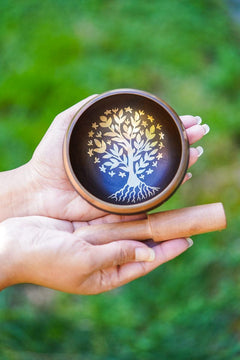What Gives Singing Bowls Their Sacred Sound?
The enchanting sound of a singing bowl is more than just a product of shape and size, it starts at the molecular level, with the metals it’s made from. For centuries, artisans across the Himalayas have combined metal with meaning, creating sacred tools that resonate with the soul.
In this blog, we explore the metals behind singing bowls, their symbolic and energetic properties, and why metal composition matters in spiritual sound healing.
The Traditional Seven-Metal Alloy
Historically, the most revered singing bowls were crafted using a seven-metal blend, each metal corresponding to a celestial body and a chakra.
The Seven Sacred Metals:
| Metal | Planet | Chakra | Symbolism |
|---|---|---|---|
| Gold | Sun | Crown | Enlightenment, purity |
| Silver | Moon | Third Eye | Intuition, clarity |
| Mercury | Mercury | Throat | Communication, flow |
| Copper | Venus | Heart | Love, compassion |
| Iron | Mars | Solar Plexus | Strength, action |
| Tin | Jupiter | Sacral | Wisdom, expansion |
| Lead | Saturn | Root | Grounding, protection |
This composition wasn't just symbolic. Each metal added unique acoustic and vibrational qualities, creating a bowl that could balance body, mind, and energy.
Many hand-hammered singing bowls from Nepal still honor this tradition, using varying combinations of these seven metals, with bronze (copper + tin) often forming the base.
Modern Compositions: Brass & Bell Metal
While traditional bowls use a multi-metal formula, modern singing bowls are commonly made from more refined or simplified alloys:
- Bronze (Copper + Tin): Produces deep, warm tones. Most widely used today for high-quality bowls.
- Brass (Copper + Zinc): Lighter in sound and often used in decorative or etched bowls.
- Bell Metal: A special high-tin bronze alloy known for rich, resonant sound. Used in premium hand-hammered singing bowls.
Though not all seven metals are present, modern alloys can still produce exceptional sound quality, especially when shaped skillfully and tuned with care.
Why Metal Composition Matters in Sound Healing
The metals in a singing bowl influence more than just sound. They affect:
1. Tone & Resonance
Heavier bowls with richer metal blends create deeper tones and stronger vibrations. Lighter alloys may sound brighter and fade faster.
2. Spiritual Energy
Each metal carries an energetic frequency aligned with different chakras or planetary forces. Bowls made with sacred metals are believed to enhance meditation and healing practices.
3. Durability & Craftsmanship
Bronze and bell metal offer strong resistance to wear and maintain tone over decades. Hand-hammered bowls often display visible hammer marks—proof of their artisan origins.
Choosing the Right Bowl Based on Metal
| Your Intention | Ideal Metal Composition |
|---|---|
| Chakra Healing | Seven-metal hand-hammered bowl |
| Deep Meditation | Bronze or bell metal |
| Yoga or Space Clearing | Brass or etched bowls |
| Crystal Work | Multi-metal bowls (spiritual range) |
Final Thoughts: Metal as Messenger
Every singing bowl carries the spirit of the elements it’s born from. The metal composition is the bowl’s voice, shaping not just what you hear - but what you feel. Whether you’re drawn to ancient tradition or modern form, the right bowl will resonate with you - body, mind, and soul.






Leave a comment